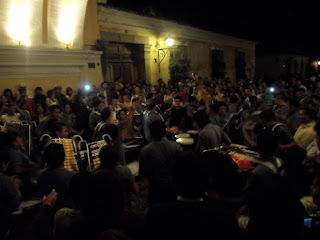The prologue to our travels. A holiday before the backpacker economy. And what better place to take that holiday. Tulum is a place of azure sea, white sand fringed with coconut-laden palm trees and a 'vibe' so mellow you could lose months rhythmically drifting away on its beach-front hammocks.
 |
| Tulum's perfect beach |
Our advance planning included the only accommodation booking of our trip - a four night stay at Ahau Tulum, perfectly situated on the Caribbean coast. Despite its picture-perfect location, development has come slowly to the Tulum coastline, perhaps due to its distance from its more famous neighbour Cancun, or nearby party-town Playa del Carmen. Rather than high-end resorts, hotels here offer individual wooden cabañas, spaciously lined up along the beach, each offering a mix of luxury or more basic rooms. Ahau is no exception, where our Guest House provided the ideal place to unwind, relax and melt into the 'mañana' culture.
 |
| Hammock time, pre-crab assault |
Our days here would be spent reclining on the beach, cooling off with dips in the sea and enjoying the best Mexico has to offer. And that best was certainly the food - it may have become famous the world over, but it's at its best at home. Highlights included the best (and biggest) plate of nachos either of us has ever tasted, extremely filling and often unusual breakfasts (which at times included mashed potato and spicy carrots) and the classic burritos and fajitas. It's no wonder you will struggle to find a skinny Mexican.
 |
| Tastiest nachos ever. Fact. |
The most dramatic event of these days would come one evening while sharing a romantic moment in a hammock, gazing at the countless stars above. Whether our heat or scent was the culprit, a local crab decided to investigate our presence and began to meander in our direction. Certain that our crustacean friend would not come more than a few feet from us, we watched his sideways crawl and beady eyes with interest. Fascination was soon replaced by terror, as our friend, increasingly resembling a mythical and deadly scorpion in our imagination, sauntered straight under our hammock and paused, claws raised, beneath us. Ali, a gentleman to the end, kindly offered Babs the door first and convinced her to jump out. Unfortunately, it transpired that this particular crab was not intimidated by Babs' presence and remained poised to strike beneath Ali, unperturbed by his screams of Scottish profanities. Deciding he would go down fighting, Ali closed his eyes, said a prayer and rolled out onto the sand. As may be expected, our friend scuttled off down the beach, taking with him Ali's last shred of pride, and accompanied by Babs' laughs of ridicule.
Despite the evening drama, our time was largely filled with inactivity, leaving Sunday as our day to explore. Renting bikes for the day, we set off in the sweltering heat for Tulum-town, set 8km inland from the coast. Our first stop was the church of Nuestra Señora de Guadalupe for morning mass. A bright and noisy celebration, it was remarkable for both the number of young people and children yet its devotion and reverence. Tulum-town itself has little to offer visitors other than a gateway to the coast and nearby Mayan ruins. However, watersports can be arranged at Mot-Mot Diving, and we can reliably confirm that the Mot-Mot Cafe nextdoor offers delightful muffins.
 |
| For all your diving needs... |
Under the early-afternoon sun, the heat was even more intense for our return cycle, not aided by Babs' attempts to break the land speed record. Finally arriving back at Ahau, Ali remarked that he hadn't sweat that much since Mr Noble last gave him a good rodgering with a squash raquet. A cold shower has never been so welcome. The remainder of our day was spent lounging by the sea and preparing for our departure to Belize the following day. However, we still afforded ourselves one last indulgence with a delicious meal at the Mexican Grill, washed down with some Coco-Loco (the ingenious addition of rum and coconut).
 |
| 2 for 1 Coco-Loco |
Writing this while waiting at the port for our boat to Belize, we are serenaded with love ballads from the cafe radio, including classics by George Michael and Sinead O'Connor. I am left wondering if our next destination will grip us in the same way as Mexico? Or if "Nothing Compares 2 U" will be this country's most fitting epitaph.





















































